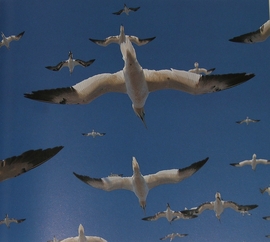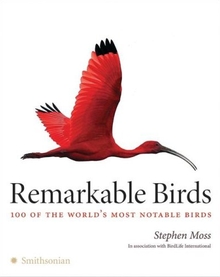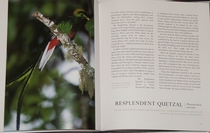Reviewed by Grant McCreary on October 22nd, 2008.
There are many reasons why people watch birds. Fundamental to them all is the notion that they are inherently worth watching. In other words, they are remarkable. There are many remarkable things about birds – the engineering marvel that is the feather, the dazzling array of plumages those feathers combine to create, and phenomena such as migration. And then there’s the little matter of flight. All birds are amazing. But like most things, this remarkableness is not evenly apportioned to all. Some birds are more noteworthy than others are. This book presents 100 birds that have been deemed the most remarkable.
Each of the 100 accounts consists of a full page of text along with a single photograph. The photographs are certainly eye-catching, with a full page devoted to all but a few. Many of them, in fact, utilize the entire page with no margins. They are, for the most part, more than adequate and well depict the highlighted species. Most illustrate a single bird in a typical portrait-type shot. But some are particularly impressive. One captures a group of Northern Gannets from below. The many birds are flying at different altitudes, but all in the same direction, like a squadron of fighters from World War II. The effect is quite striking.
On the other hand, a few are disappointing. Some seem just a little out of focus, or perhaps they were reproduced a bit too largely. Also, four photos are printed small enough that they are included on the same page as the text. Presumably, for these birds the author was unable to obtain photos of sufficient quality to allow them to be shown on the same scale as the rest. Altogether, though, the photography is satisfying and adds greatly to this volume.
At first glance, this would seem an easy book to write. All the author has to do is gather nominations and write a bit about each species. Nothing could be further from the truth. The author has the unenviable task of describing, in a small amount of space, what makes each of these species remarkable. For the most part, he was successful. For the majority of species, including surprises such as the House Sparrow, Moss is very convincing on why it deserved to be selected. However, a few didn’t work quite so well. I did not glean anything about the Dartford Warbler, for instance, that would explain why it was particularly remarkable.
Since a full life history of each species is out of the question, the accounts instead focus on one or two aspects that make the bird unique. That may include ecological requirements, conservation status, breeding, or physiological characteristics. I found the accounts to be interesting and enlightening, and I learned many cool things, such as:
- Common Eiders have one of the fastest recorded level flight speeds (the book says it has the fastest, but several other sources I’ve found list one of 2 swifts, so I’m not sure. Regardless, I was still surprised about the eider)
- The Bald Eagle’s nest is the largest tree nest of any bird in the world, and can weigh almost three tons
- Female hornbills wall themselves up in a tree cavity to lay their eggs, leaving open only a small slit so that her mate can provide food. They don’t leave until the young have hatched and are ready to fledge. The female takes this opportunity to molt all flight feathers simultaneously. If something happens to the male, then the female and all young will die, because even if she breaks out early she will still be flightless.
Although the bird’s distribution is described, range maps would have been very welcome.
The first question/concern most readers would have of books such as this is how does one determine which species to include? Such a list is inherently subjective, and not many single birders have seen enough of the world’s birds to make a reasoned, well-rounded list. Thus, it was a relief to find that the author did not take this route. Instead, like the author of Fifty Places to Go Birding Before You Die before him, he solicited nominations from many fellow birders, ornithologists, and conservationists. The resulting list of more than 500 nominated species was whittled down to a reasonable selection of the world’s most remarkable birds.
Obviously, no one will agree with all the choices here. Some, such as the following, are virtually incontestable: Hoatzin; Shoebill; Resplendent Quetzal; Peregrine Falcon; and New Caledonian Crow (the only species besides humans known to make tools). But there is room for disagreement over many of the choices. For instance, of all the New World Warblers, is the Kirtland’s truly the most remarkable? It is undeniably a cool bird, but I would propose that the Blackpoll Warbler, with its nonstop 2,000+ mile over water flight to South America, is much more amazing, if less desirable to birders than the very rare Kirtland’s. But most of the birds presented here clearly have merit, and I consider any thought or debate stimulated by these selections as a positive thing.
Thus, I refrain from passing judgment on the selections. But there are some other aspects that deserve it. The most obvious issue is numerous typographical errors where hyphens are inserted where not needed. This book was previously published in England, and I assume that these words were split across lines in that edition, necessitating the hyphens. But they were not removed from this American version, even though layout changes meant that they were no longer required. Additionally, the introduction gives a website address where readers can submit their own selections, but that url is not valid, and some searching did not turn up the page.
There are also a few errors in the content. One account mentions that the majority of the long-tailed tits (Aegithalidae) reside in North and Central America. However, just one, the Bushtit, does. Most are found in the Himalayas or the mountains of China (source). The author also got a little carried away when writing about the California Condor when he says that their “very last stronghold….no longer sounded to their haunting cry”. Condors, like the other North American vultures, are rarely heard and are technically voiceless.
Such errors as these are unfortunate, but honestly are not a big deal. However, I did come across an issue that was very significant. Again in the condor account, the “tagline” for the species reads:
Nowhere else could a species that symbolizes the go-getting, frontier mentality of its homeland be allowed to reach the verge of extinction
Personally, I was taken aback by this. I will be the first to admit that what was allowed to happen to the condors was awful, and criticism is deserved. Still, this seems especially harsh and misplaced in this type of book. I was relieved to find nothing of this sort written about the Whooping Crane, another North American species that teetered on the edge of extinction. But the worst was yet to come, in this comment about the Ivory-billed Woodpecker:
What is tragic about the decline – and probably extinction – of the Ivory-billed Woodpecker is that the world’s largest economy allowed one of its greatest natural treasures to decline to the point of no return. Then, having supposedly rediscovered the bird, more effort was put into exploiting its presence than into confirming whether or not the sighting was genuine.
Excuse me? Again, the first part is true – it is tragic. But the wording seems to imply more than that, it seems to be truly anti-American. And then that second part is a complete lie. Yes, there were people in the area that “exploited” the sighting economically. But when you get right down to it, can’t you say that about most ecotourism? (That’s not a knock; I don’t see anything wrong with it). And then the author apparently completely ignores the thousands of man-hours that have been devoted to confirming the bird’s presence.
Maybe I’m reading too much into it, but it definitely left a bad taste in my mouth.
Recommendation
I’m a bit leery of Top…..whatever books such as this one. But that misapprehension started to melt away as I picked up Remarkable Birds. The cover is attractive and elegant, qualities that are also evident in the design throughout the rest of the book. The photography is certainly striking, but the true pleasure is in learning about these creatures. I do have some serious issues with some of the things the author wrote and implied. However, I had great fun reading about these birds, and I still think this would make a nice gift or book to have around and browse through. All but the most hardcore world birders will discover some great new birds.
Here is the complete list of the 100 birds presented in this book.
Disclosure: I get a small commission for purchases made through links in this post.
Disclosure: The item reviewed here was a complementary review copy provided by the publisher. But the opinion expressed here is my own, it has not been influenced in any way.






Would you list the 100 species, please? Just curious. To me, it is more bird groups that I would want to see. Like at least one representative of the pittas, woodswallows, fairy-wrens, nandus, seed snipes etc.
Here is the complete list.
It looks like only 1 of the 5 groups you mentioned are represented. The author did state that he tried to limit it to no more than 2 representatives from any given family or group. He kept to it for the most part, except for the raptors and shorebirds. And having 2 of the world’s 15 cranes included may be a bit much. But cranes are amazing, so I can’t fault that too much.